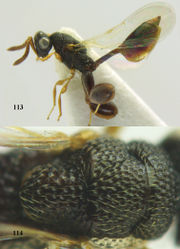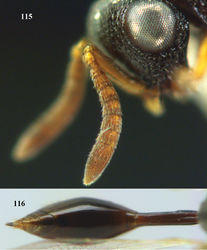Epitranus neonigriceps
| Notice: | This page is derived from the original publication listed below, whose author(s) should always be credited. Further contributors may edit and improve the content of this page and, consequently, need to be credited as well (see page history). Any assessment of factual correctness requires a careful review of the original article as well as of subsequent contributions.
If you are uncertain whether your planned contribution is correct or not, we suggest that you use the associated discussion page instead of editing the page directly. This page should be cited as follows (rationale):
Citation formats to copy and paste
BibTeX: @article{Narendran2016ZooKeys, RIS/ Endnote: TY - JOUR Wikipedia/ Citizendium: <ref name="Narendran2016ZooKeys">{{Citation See also the citation download page at the journal. |
Ordo: Hymenoptera
Familia: Chalcididae
Genus: Epitranus
Name
Epitranus neonigriceps Narendran & van Achterberg, 2016 sp. n. – Wikispecies link – ZooBank link – Pensoft Profile
Type material
Holotype, ♀ (RMNH), “Vietnam, Viet Try, n[ea]r Tanh Son, Thuong Cuu, 20°59'N, 105°8'N, 360–400 m, 11–16.x.1999, Malaise traps, R. de Vries, RMNH’99”. Paratypes (RMNH, IEBR): 3 ♀, same data as holotype; 2 ♀, “N. Vietnam: Ninh Binh, Cuc Phuong N. P., n[ea]r entrance, c. 225 m, 15–27.v.2000, Mai Phu Quy, RMNH’00”; 1 ♀, id., but near centre, 1.xi.–20.xii.2000.
Diagnosis
This new species comes to Epitranus nigriceps Bouček in the keys by Bouček (1982)[1] and Narendran (1989)[2], but differs from it in having: 1) interstices between punctures narrower than diameter of a puncture on mesoscutum and axillae (in Epitranus nigriceps interstices between punctures broader than diameter of a puncture in many places on mesoscutum and axillae); 2) post-spiracular teeth present (in Epitranus nigriceps post-spiracular teeth absent); 3) post-orbital carina reaching posterior margin of gena (in Epitranus nigriceps post-orbital carina running upwards to near lateral ocellus); 4) eyes sparsely setose (in Epitranus nigriceps eyes bare); 5) funicular segments mostly transverse (in Epitranus nigriceps funicular segments slightly elongate); 6) mesosoma and metasoma darker (in Epitranus nigriceps mesosoma and metasoma more reddish); 7) metasoma pointed at apex (in Epitranus nigriceps metasoma rather blunt at apex); 8) sublateral and submedian carinae of propodeum a little convex (in Epitranus nigriceps sublateral and submedian carinae of propodeum straight), and 9) POL 1.3 × OOL (in Epitranus nigriceps POL 1.7 × OOL).
Description
Holotype, ♀, length of body 3.5 mm.
Colour. Head black; eyes gray with punctures, reflecting yellow spots; ocelli pale reflecting yellow; scape and pedicel yellow; anellus yellowish brown; remaining segments pale brown; clypeus and mandibles pale brownish yellow; mesosoma black with tegulae pale yellow; metasoma liver brown mixed with black; fore and mid legs yellow except fore coxa slightly darker basally; hind coxa, trochanter and femur reddish brown with darker median part of outer disc of hind femur and brownish yellow apex of hind coxa; hind tibia pale brownish yellow; all tarsi pale yellow; wings hyaline with veins pale yellowish hyaline.
Head. Head as broad as mesoscutum (including tegulae); width in anterior view 1.2 × its height; width in dorsal view twice its length; POL:OOL:AOL:LOL = 8:6:5:4; eye height in profile 1.2 × its length; malar space 0.6 × eye height in profile; face with close, setigerous punctures, interstices narrower than diameter of a pit in most spaces, smooth, shiny; occiput and vertex similarly punctate as face; face in dorsal view broadly convex; ocelli in broad triangle; scrobal area with arcuate striation; clypeal shield tri-lobed at apex, sides upturned, concave surface dull with some short setae, sub-torular carinae weak, narrow interantennal space with small lamina; pre-orbital carina weak; post-orbital carina strong, reaching posterior margin of gena; no malar ridge (carina), scape not reaching anterior ocellus, flagellum barely thickened distally; F1 as broad as pedicel in dorsal view; pre-claval segments slightly wider than long.
Mesosoma. Mesosoma with close umbilicate, setigerous punctures, interstices narrower than diameter of a puncture, smooth and shiny except reticulate area near anterior margin of mesoscutum; pronotum with anterior lateral carina very weakly represented, not high; lateral ledge present. Scutellum longer than broad (9:8), its dorsum moderately convex; propodeum with median area precurrent, with a pair of submedian carinae enclosing areola, postspiracular teeth distinct.
Wings. Fore wing with short STV, fringe absent, pilosity distinct on distal half, glabrous below veins and no distinct hairline.
Legs. Hind coxa with distinct close setigerous punctures on outer side, narrow interstices smooth; hind femur with a large basal tooth followed by 8–9 gradually smaller teeth; tibia with slightly indicated hump, moderate dorsal pilosity, tarsal sulcus confined to distal 0.4 of tibia; spine reaching trochanter in folded position.
Metasoma. Petiole 3.8 × as long as broad, twice as long as scutellum, 0.8 × length of T1; metasoma elongate, apex pointed.
Male. Unknown.
Host
Unknown.
Distribution
Vietnam.
Variation
In some paratypes the funicle is more yellowish brown and the metasoma is darker than in the holotype.
Original Description
- Narendran, T; van Achterberg, C; 2016: Revision of the family Chalcididae (Hymenoptera, Chalcidoidea) from Vietnam, with the description of 13 new species ZooKeys, (576): 1-202. doi
Images
|
Other References
- ↑ Bouček Z (1982) Oriental chalcid wasps of the genus Epitranus. Journal of Natural History 16: 577–622. doi: 10.1080/00222938200770451
- ↑ Narendran T (1989) Oriental Chalcididae (Hymenoptera: Chalcidoidea). Zoological Monograph. Department of Zoology, University of Calicut, Kerala, 1–441.

